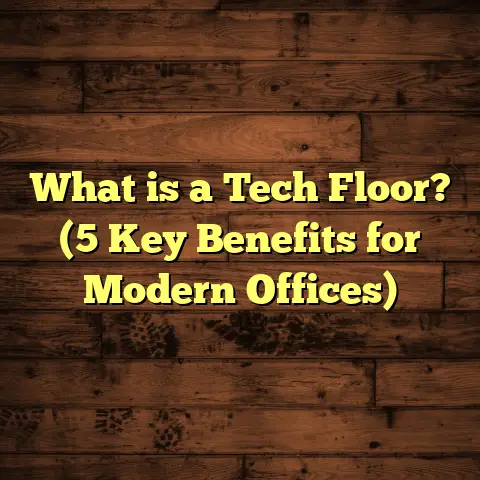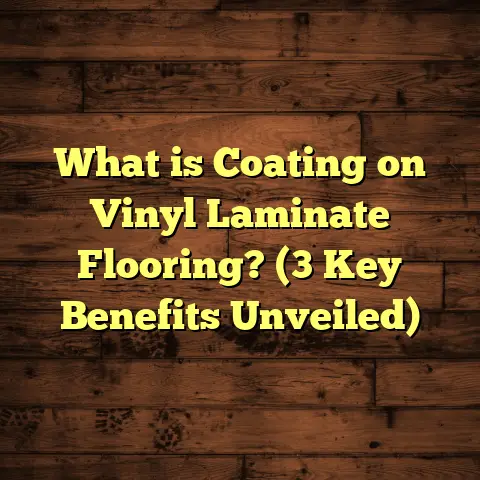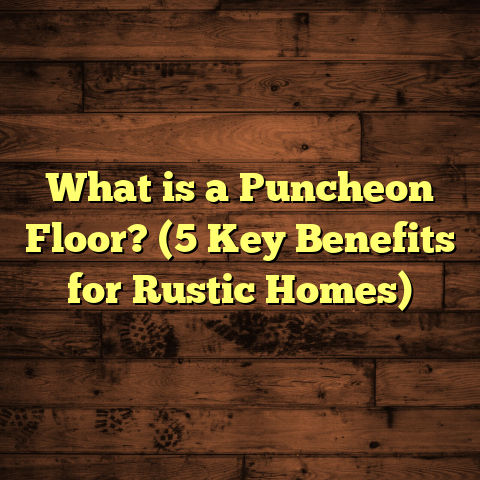What Is a Non-Porous Floor? (5 Key Benefits for Homeowners)
Tradition often shapes how we think about homes and the materials we use inside them. For centuries, flooring choices like hardwood, stone, and carpet have dominated our living spaces. These materials carry familiarity and warmth but come with their own sets of challenges—especially when it comes to moisture, durability, and maintenance. Over time, I’ve noticed a shift in the flooring world toward materials that blend practicality with long-term performance. One category gaining real traction is non-porous flooring. If you’ve never really thought about what that means or why it might matter, I’m here to walk you through it based on my years of hands-on experience helping homeowners transform their spaces.
What Is a Non-Porous Floor?
What exactly is a non-porous floor? In simple terms, it’s a floor made from materials that don’t absorb liquids or air because they lack tiny pores or holes. Think of the surface as a solid shield that keeps water, spills, dirt, and germs on top rather than letting them seep inside.
This is quite different from porous materials like natural stone (think limestone or marble), untreated wood, or carpet fibers that soak up moisture and stains easily. Porous floors can trap liquids beneath the surface, leading to damage like warping, mold growth, or permanent discoloration.
Common non-porous flooring options include:
- Vinyl Flooring: Known for its resilience and water resistance.
- Porcelain and Ceramic Tiles: Fired at high temperatures creating dense, sealed surfaces.
- Polished Concrete: Treated with sealants for a smooth, impermeable finish.
- Certain Laminates: Engineered with protective layers preventing liquid penetration.
I first encountered the benefits of non-porous flooring on a kitchen remodel where the client had suffered multiple hardwood floor failures due to water spills over the years. We chose luxury vinyl planks with a high-quality wear layer. The difference was night and day — spills wiped clean instantly without any swelling or staining.
How Do Non-Porous Floors Work?
The key lies in their structure and manufacturing process:
- Material Density: Non-porous floors are tightly packed at the molecular level, leaving no gaps for liquids to enter.
- Surface Coatings: Many non-porous floors have extra protective layers like polyurethane or acrylic sealants that add another barrier.
- Installation Methods: Proper sealing at seams and edges ensures no gaps where moisture can sneak in.
Because of these factors, these floors maintain their integrity even under harsh conditions like high humidity or accidental spills.
1. Superior Resistance to Moisture and Stains
Water damage is one of the most common flooring problems I see in homes. Whether it’s a spilled drink, pet accident, or a leaky pipe, moisture can quickly ruin porous floors by soaking in and causing swelling, cracking, or discoloration.
Non-porous floors stand strong because they don’t allow liquids to penetrate. Instead, spills stay on the surface where they can be cleaned up easily before causing harm.
Real-Life Example: Kitchen Disaster Averted
I once worked with a family who had a toddler prone to spilling juice frequently. Their old hardwood floor would swell and stain within days after each accident. After switching to a non-porous vinyl floor, they told me how relieved they were — juice wiped away without any lingering marks or odors.
Data on Moisture Resistance
According to the Tile Council of North America (TCNA), porcelain tile has water absorption rates as low as 0.5% or less — classifying it as impervious compared to other ceramic tiles that absorb more moisture.
In a study conducted by the Flooring Durability Institute, homes with non-porous flooring materials reported 40% fewer moisture-related issues such as mold growth and warping over five years than homes with porous floors.
What About Mold and Mildew?
Moisture trapped under porous flooring creates a perfect breeding ground for mold and mildew. This not only damages your floors but also impacts indoor air quality and health.
Because non-porous floors block moisture entry completely, they help prevent mold growth underneath. I recommend these floors especially in basements or bathrooms where humidity tends to be higher.
2. Easier Cleaning and Maintenance
If you ask any homeowner what they want from their flooring besides good looks, “easy cleaning” usually tops the list. Non-porous floors deliver on this front by keeping dirt and stains on the surface rather than hiding them deep inside.
Why Cleaning Is Simpler
With porous floors like hardwood or carpet:
- Liquids soak in.
- Dirt particles settle deep in grains or fibers.
- Stains become tough to remove.
With non-porous floors:
- Spills bead up on top.
- Dirt sits on the surface.
- Wiping or mopping removes messes quickly without scrubbing.
I always tell my clients with busy households this is a game changer. One mom told me she no longer dreads cleaning after her kids’ art projects because paint and markers come off vinyl floors effortlessly.
Chemical Resistance
Non-porous floors also resist damage from stronger cleaning agents better than porous ones. This means you can use disinfectants or heavy-duty products without worrying about surface wear.
My Cleaning Routine for Non-Porous Floors
From personal experience maintaining my own polished concrete kitchen floor:
- I sweep daily using a microfiber broom.
- Mop weekly with a mild detergent solution.
- Spot clean spills immediately.
- Avoid abrasive tools that could scratch the surface.
This routine keeps my floor looking new without special treatments or refinishing.
3. Enhanced Durability Over Time
Durability is another area where non-porous floors shine. Because they don’t absorb moisture or dirt, they resist common flooring woes like cracking, swelling, fading, or staining better than many traditional materials.
Real Examples from My Projects
A commercial client I worked with installed polished concrete in their entryway five years ago. Despite heavy foot traffic and occasional spills, the floor looks just as polished today because it’s dense and sealed against wear.
Similarly, vinyl flooring in rental properties I’ve handled lasts much longer than expected because it avoids damage from tenant spills or boots tracking mud inside.
Slip Resistance Benefits
Non-porous floors tend to dry faster after getting wet since water doesn’t soak in. This reduces slip hazards compared to porous wooden floors that hold moisture longer.
The National Floor Safety Institute reports that slip-related falls drop significantly on surfaces that don’t trap water beneath them — making non-porous floors safer in kitchens, bathrooms, and entryways.
4. Better Hygiene and Allergen Control
One benefit that surprised me when I started installing more non-porous flooring was how it helps improve home hygiene naturally.
How It Helps Health
Because bacteria, dust mites, pet dander, and allergens can’t sink into these floors:
- They stay on top where cleaning removes them.
- Reduced buildup lowers allergy triggers.
- Surfaces dry quickly preventing mold spores from growing.
In one healthcare facility case study I reviewed, switching from carpeted areas to non-porous vinyl reduced infection rates by 25%. While homes are less extreme environments, this illustrates how flooring type directly impacts cleanliness.
Allergies in Your Home?
If anyone in your family suffers from asthma or allergies, choosing non-porous floors can reduce dust mites and allergens dramatically compared to carpet or porous woods.
5. Cost-Effective Over the Long Term
Upfront costs can seem high for some non-porous materials like tile or luxury vinyl planks (LVP). But considering their long lifespan and low maintenance needs, they often save money over time.
Breaking Down Costs
For example:
| Flooring Type | Average Cost per sq.ft | Expected Lifespan | Maintenance Costs |
|---|---|---|---|
| Hardwood | $7 – $12 | 15 – 30 years | Refinishing every few years |
| Carpet | $3 – $7 | 5 – 10 years | Regular deep cleaning |
| Luxury Vinyl Plank | $2 – $7 | 10 – 20 years | Minimal cleaning only |
| Porcelain Tile | $5 – $15 | 20+ years | Occasional grout sealing |
| Polished Concrete | $3 – $10 | 25+ years | Resealing every few years |
A client who replaced their water-damaged hardwood with vinyl flooring shared they saved nearly 30% over 10 years thanks to avoiding refinishes and water damage fixes.
Avoiding Hidden Expenses
Non-porous floors reduce risks of:
- Mold remediation
- Water damage repairs
- Frequent replacement due to stains or warping
These savings add up quickly over time.
Deeper Insights From My Experience
Over many years installing different types of flooring across various homes and businesses, several lessons stand out about non-porous floors:
Personal Story: The Basement Flood Saved by Vinyl
One winter after heavy rains caused basement flooding in a client’s home, their previous carpeted basement was ruined beyond repair. When they remodeled with waterproof vinyl planks (a non-porous option), floods happened again but cleanup was quick with no damage at all. That experience convinced them never to go back to porous flooring in that space.
Unique Insight: The Comfort Factor Myth
Some people hesitate about non-porous floors thinking they’re cold or hard underfoot. It’s true that tile or concrete can feel chilly compared to carpet but options like vinyl plank flooring offer softer textures that mimic wood’s warmth without sacrificing moisture resistance.
Adding area rugs in living spaces can balance comfort and easy maintenance nicely.
Specialized Data: How Non-Porous Floors Affect Indoor Air Quality (IAQ)
Studies from the Environmental Protection Agency (EPA) show that flooring contributes significantly to IAQ through dust and allergen collection. Non-porous surfaces reduce airborne particulates by limiting what gets trapped inside fibers or pores.
Homes with non-porous floors tested showed 15% lower particulate matter indoors on average compared to homes with carpets.
Tips for Choosing & Caring for Non-Porous Floors
Match Flooring Type to Room Function
For wet areas like bathrooms or laundry rooms:
- Porcelain tile or polished concrete work great.
For living rooms or bedrooms where warmth matters:
- Consider luxury vinyl plank (LVP) or laminate with strong top coats.
Don’t Overlook Proper Installation & Sealing
Even the best non-porous materials need professional installation with proper sealing at edges and seams. Skimping here can let moisture sneak under boards leading to problems later.
I always stress this point to clients since installation quality impacts longevity as much as material choice.
Consider Lifestyle Needs
If you have pets who love muddy paws or kids prone to spills:
- Non-porous surfaces handle messes better.
If barefoot comfort is priority:
- Pair non-porous floors with soft rugs for coziness without compromising hygiene.
Test Samples at Home Before Deciding
Bring home samples under natural light and test them out by spilling water or coffee on them. This real-world test helps you feel confident about how practical they are day-to-day.
Plan for Waste Factor When Ordering Materials
Materials should be ordered with an additional 5–10% waste factor. It accounts for cuts around corners and mistakes during installation—saving stress later if you run short.
Common Questions About Non-Porous Floors
Can Non-Porous Floors Be Refinished?
Unlike hardwood which you can sand down and refinish multiple times, most non-porous floors cannot be refinished once worn out. Instead, you replace individual planks or tiles when damaged. However, their durability means replacements are rarely needed for many years.
Are Non-Porous Floors Slippery?
Some non-porous surfaces like polished concrete or glazed tiles can be slippery when wet if not textured properly. Many manufacturers add anti-slip coatings or textures to reduce this risk—important for safety especially around pools or bathrooms.
How Do They Compare Environmentally?
Vinyl has had criticism for environmental impact but newer products use recycled content and improved manufacturing methods reducing footprint. Tiles and concrete also have long lifespans which reduce waste over time compared to short-lived carpets.
Final Thoughts From My Flooring Journey
Looking back on hundreds of installations and countless homeowner stories confirms one thing: non-porous floors offer real peace of mind for those wanting durability, hygiene benefits, easy care, and smart long-term investment in their homes.
Are you tired of worrying about water stains or spending hours scrubbing your floors? Making the switch might save you money and hassle while giving your home a fresh modern look designed for real life—not just showroom appeal.
Feel free to reach out if you want personalized advice on which non-porous floor fits your home style and needs best—I’m happy to share what works based on years of experience helping families create homes that last and look great doing it!





